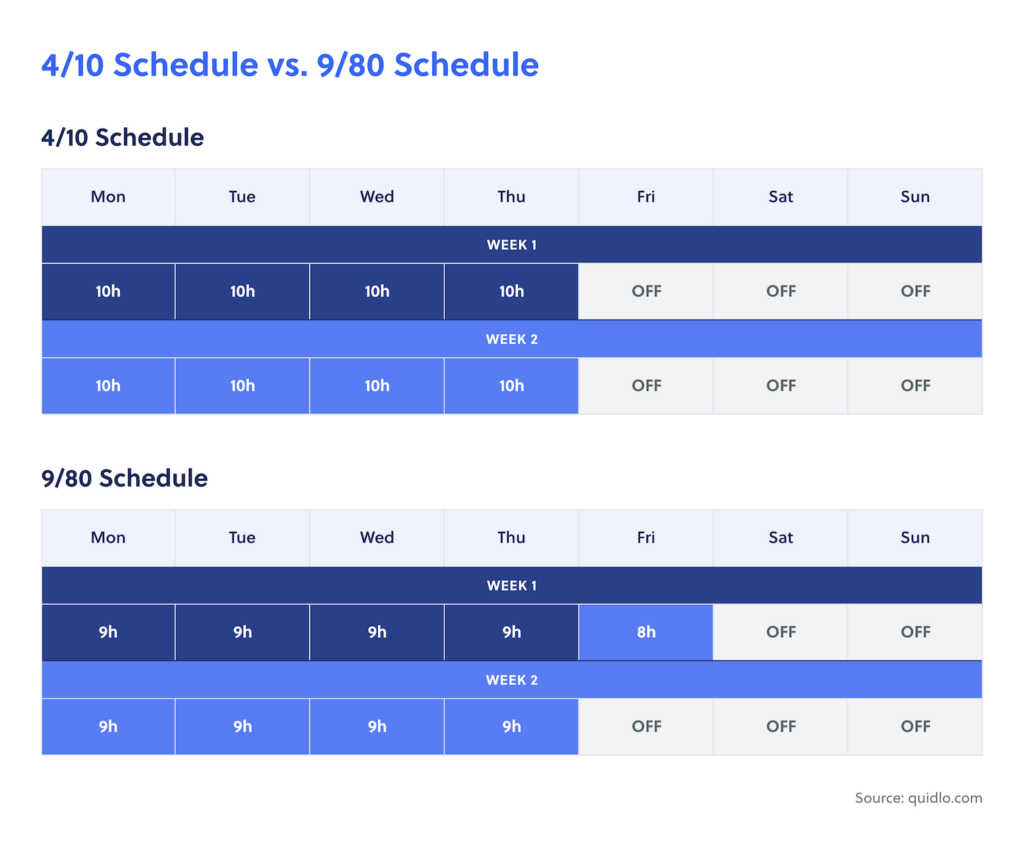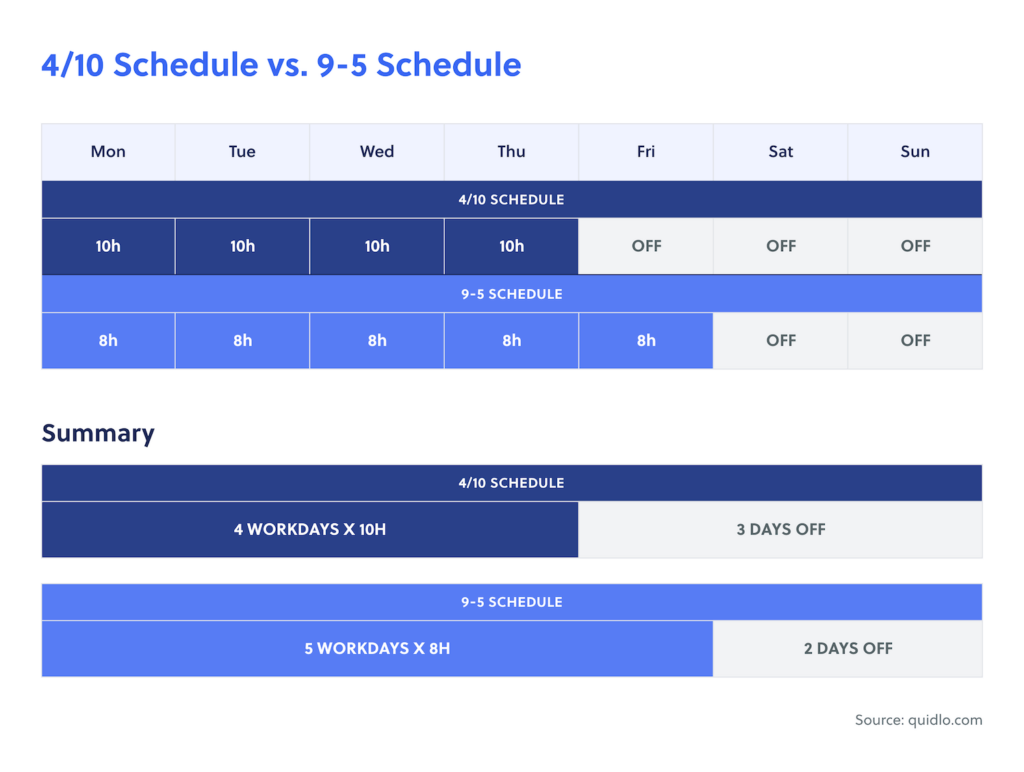Did you know that there is a new type of work schedule that is becoming increasingly popular in today’s world? It’s called the 4/10 work schedule, and it offers some unique benefits and drawbacks compared to other options. In this post on Quidlo, we’ll explore what a 4/10 work schedule is, as well as the pros and cons associated with it. Plus, we’ll give you some examples of how this type of schedule could work for you. Read on to learn more!
Table of Contents
What is a 4/10 Work Schedule?
The 4/10 schedule is a unique arrangement for a workweek in which an employee works four 10-hour shifts and has three days off. This schedule can be beneficial for both employers and employees, as it allows for longer periods of rest and increased productivity during work hours. It can also offer added flexibility in scheduling, as there are five weekdays available for time off instead of just two, allowing for more time to attend appointments or take vacation days. In certain industries, like retail and hospitality, this schedule can also be helpful in planning staff coverage.
How Does the 4/10 Schedule Work?
Ever heard the phrase “work smarter, not harder“? That’s exactly what the 4/10 schedule is all about. The 4/10 work schedule is just like it sounds – employees work four 10-hour shifts, followed by three days off. This schedule allows for a longer weekend while maintaining a traditional 40-hour workweek. Many industries, including manufacturing and healthcare, utilize the 4/10 schedule to increase productivity and improve employee satisfaction. However, such a schedule can also lead to burnout if not properly managed. Communication between co-workers on their schedules is crucial to ensuring tasks are completed during the working days. For those looking for a longer weekend or greater flexibility in their work week, the 4/10 schedule could be just the ticket.
4/10 Work Schedule Variations
Flexible 4/10 work schedule
With a flexible 4/10 schedule the employees have the freedom to choose between:
- Their off days; make a personalized schedule where they choose when they don’t have to work.
- Their work hours; with a flexible 4/10 schedule it’s up to the employees to decide when to come to work and when to leave.
4/10 shifts
Your business can still operate as a normal establishment from Monday to Friday.
Businesses who implement a 4/10 work schedule divided their employees into groups. That way, you will always have someone working through Monday to Friday, their desired hours a day. So one group consists of people who want work week to start from Tuesday, and another can cover for them on Monday while taking Tuesday off.
Seasonal 4/10 Shifts
Retail stores, and other entities that require additional aid during the holiday seasons or particular times of the year can use a 4/10 work schedule to hire more people during that time and keep them active. On normal months these people can be issued off days, and vacation plans. In that way, the company can use the workforce they have without making it difficult for the individuals as both the company and the worker’s interests align.
Pros and Cons of 4/10 Work Schedule
The 4/10 work schedule is becoming increasingly popular in the corporate world. It allows employees to have every other Friday off, while still maintaining a 40-hour work week. Sounds too good to be true, right? Let’s take a closer look at the pros and cons of this scheduling trend.
Advantages of a 4-day 10-hour Work Week
Though unorthodox, there are many advantages of a 4/10 hour work week. This is true for both the workers and the employers. Some of the key advantages include;
| Employee Benefits | Employer Benefits |
|---|---|
| Increased Flexibility | Increased Focus and Productivity |
| Improved Work-Life Balance | Increased Accountability |
| Reduced Stress Levels | Increased Efficiency |
| More Opportunities for Overtime | Improved Work-Life Balance |
| Easier Commute Times | Increased Flexibility |
Employee Benefits of the 4/10 Schedule
1. Increased Flexibility
Employees who work a 4/10 schedule have increased flexibility with their days off. They can choose to work four consecutive 10-hour days, or work 10 hours one day and have the next day off. This flexibility allows for a better work-life balance.
2. Improved Work-Life Balance
With a 4/10 schedule, employees have more time to spend with their families and friends outside of work. They can also use this time to take care of personal errands or appointments without having to take vacation days or miss work altogether.
3. Reduced Stress Levels
Employees who work a 4/10 schedule often report lower stress levels than those who work traditional hours. This is because they have more time to relax outside of work and are able to get more restful sleep since they are not working late into the night.
4. More Opportunities for Overtime
Since employees on a 4/10 schedule are working 10-hour days, they often have more opportunities for overtime hours. This can be especially beneficial if they need to make extra money or want to receive larger paychecks.
5. Easier Commute Times
Employees who work a 4/10 schedule often have easier commute times than those who work traditional hours. This is because the majority of people are available to commute during the morning and evening rush hours, which leaves the middle of the day less congested.
Employer Benefits of the 4/10 Schedule
1. Increased focus and productivity
When employees know that they have a limited amount of time to complete a task, they are more likely to focus on the task at hand and be more productive. This is because they don’t want to waste time and they want to get the task done as quickly as possible.
2. Increased accountability
Employees who are working on a 4/10 schedule are held accountable for their time. They can’t slack off or take too much time on one task, because they only have four hours to work on it. This helps to ensure that employees are productive and efficient with their time.
3. Increased efficiency
With a 4/10 schedule, employees are able to complete tasks more quickly because they are focused and have fewer distractions. This leads to increased efficiency in the workplace and improved productivity overall.
4. Improved work-life balance
A 4/10 schedule allows employees to have more free time outside of work, which can improve their work-life balance. This is especially beneficial for those who struggle to find a good balance between their work and personal lives.
5. Increased flexibility
A 4/10 schedule is flexible, which means that it can be adapted to meet the needs of employees and businesses. This makes it a versatile option for both employers and employees alike.
Disadvantages of the 4/10 Work Schedule
The grass isn’t always greener on the other side. While a 4/10 work plan may appear to be the perfect fantasy, providing for longer weekends and more spare time, it can actually lead to employee and employer burnout. Let’s look at the disadvantages of the 4/10 work schedule from the standpoints of both employees and companies.
| Employee Disadvantages | Employer Disadvantages |
|---|---|
| Little time for rest or relaxation | Increased overtime costs for employees. |
| Overworked and stressed | Employees may feel overworked and overstretched |
| Disruptive to family life | Lower productivity due to fatigue |
| Hard to adjust to | Poor work-life balance for employees |
| Fewer opportunities for advancement | Difficulty in scheduling meetings and appointments |
Employee Downsides of the 4/10 Schedule
1. Little time for rest or relaxation
The 4/10 workweek is a compressed schedule that leaves employees with little time for rest or relaxation. This schedule can be very demanding and stressful, which can disrupt family life and personal obligations.
2. Overworked and stressed
Employees often feel overworked and stressed due to the compressed schedule of the 4/10 workweek. This schedule can be very demanding and leaves little time for rest or relaxation. This can be disruptive to family life and personal obligations.
3. Disruptive to family life
The 4/10 workweek can be disruptive to family life and personal obligations. This schedule is very demanding and leaves little time for rest or relaxation. This can be very disruptive to family life and personal obligations.
4. Hard to adjust to
Adjusting to a new schedule can be difficult, especially if you are not used to working long hours. When you are working four 10-hour days, it can be hard to get used to the new schedule because it is very different from what you are used to. You may find that you are not as productive on the new schedule because you are not used to working that many hours in a row.
5. Fewer opportunities for advancement
There are fewer opportunities for advancement in a company that utilizes a 4/10 schedule. When you work four 10-hour days, there are fewer opportunities for advancement because you are not working the traditional five days per week. This means that there are fewer chances for you to move up within the company or take on additional responsibilities.
Employer Downsides of the 4/10 Schedule
1. Increased overtime costs for employees.
The 4/10 work schedule can lead to increased overtime costs for employees, as they may be required to work longer hours in order to complete their tasks. This can be especially challenging for those with families or other responsibilities that require their time outside of work.
2. Employees may feel overworked and overstretched.
Working ten hours per day, four days per week can be physically and mentally demanding for employees. They may feel overworked and overstretched, which can lead to decreased productivity and burnout.
3. Lower productivity due to fatigue.
Employees who are tired from working long hours may have lower productivity levels. This can impact the company’s bottom line and its ability to meet deadlines.
4. Poor work-life balance for employees.
The 4/10 work schedule can lead to a poor work-life balance for employees, as they may struggle to find enough time for both their professional and personal lives. This can cause stress and frustration, and may lead to dissatisfaction with their job.
5. Difficulty in scheduling meetings and appointments.
The 4/10 work schedule can make it difficult for employees to schedule meetings and appointments, as they may not be available during the traditional 9-5 workday. This can inconvenience coworkers and clients who are used to working within those hours.
Is a 10-Hour Workday Too Long?
With the rise of the “hustle culture,” a never-ending workday has almost become a badge of honor. But does this long day actually benefit productivity? The answer might surprise you. As Yogi Berra famously stated, “In theory, there is no difference between practice and theory. In practice, there is.”
To put it another way, if you’re a machine, working longer than 8 hours a day should pay off in productivity increases. However, most of us are not machines; as the day progresses, we quickly tire, get distracted, and become inefficient in our job.
This means that a 10-hour day could result in lower productivity compared to an 8-hour day. And it’s not just during the actual workday that these effects can be felt – Without enough rest, our brains struggle to process information and make decisions effectively. Lack of sleep can also have a negative impact on creativity.
When it comes to productivity in the workplace, it is often assumed that longer hours equal more work completed. However, evidence suggests otherwise. Here are five ways a 10-hour workday can actually have a negative impact on productivity:
- It leads to burnout and fatigue, resulting in decreased motivation and reduced cognitive function.
- It reduces overall work-life balance, leading to stress and unhealthy habits such as lack of exercise and poor diet.
- It hinders creative thinking, as people are less likely to take breaks or have time for outside hobbies and interests.
- It can create a toxic work environment where employees feel pressure to constantly be “on” and available.
- It can lead to increased errors and mistakes, as tired employees are less able to focus and make careful decisions.
So next time you’re tempted to put in extra hours at the office, remember that sometimes less really is more. Taking care of yourself and allowing for necessary rest will ultimately result in improved productivity.
Who is the 4/10 Work Schedule for?
The 4/10 work schedule is perfect for a variety of industries and individuals. For shift workers, it allows for three full days off each week, offering more opportunities for rest and relaxation.
The schedule is also beneficial for busy parents who need to arrange childcare or attend school events. On top of that, industries such as healthcare, hospitality, retail, transportation, and emergency services can see an increase in productivity and morale with the 4/10 schedule.
How Popular is the 4/10 Work Schedule?
The 4/10 work schedule, also known as the “compressed work week,” has grown in popularity over the last few decades. According to a recent survey conducted by Qualtrics, a provider of cloud software, a massive 92% of American workers support a shorter workweek.
Autonomy published a study in which they followed 2,500 workers who cut their workweek to 35 or 36 hours without a decrease in salary. Employees’ satisfaction, as measured by a variety of factors such as health and work-life balance, rose considerably throughout the course of the study’s time period. Despite working fewer hours, output did not drop and may have even increased.
It can also have environmental benefits, as fewer commute days result in lower emissions. However, it’s important to note that not every job is well-suited for this type of schedule. While it may work well for office settings, jobs with customer service hours or on-call shifts may not have the flexibility to adopt this schedule.
Overall, the 4/10 work schedule offers unique benefits for both employees and employers – and its popularity will likely continue to grow.
Examples of 4/10 Work Schedule
Often referred to as the “compressed workweek,” this trend is gaining traction across a number of sectors. Some common fields or areas of work that frequently employ the 4/10 schedule are listed below.
1. Manufacturing: The 4/10 work schedule is often used in manufacturing because it allows for employees to have a three-day weekend. This gives them time to rest and recharge, which is important for workers who are often on their feet all day.
2. Retail: The 4/10 work schedule is often used in retail because it allows for employees to have a better work-life balance. With four days of work and only ten hours per day, employees are able to spend more time with their families and friends.
3. Food Service: The 4/10 work schedule is often used in food service because it allows for employees to have more time to cook and prepare food. This is important, as food service is a fast-paced industry where every second counts.
4. Healthcare: The 4/10 work schedule is often used in healthcare because it allows for employees to have more time to care for patients. With ten hours per day, employees are able to provide better care for their patients.
Companies Using a 4/10 Work Schedule
The traditional five-day workweek may be a thing of the past, as more and more companies are experimenting with new models that prioritize employee wellbeing and productivity. The 4/10 model, for example, pushes employees to work hard during the week but also encourages them to take time off on weekends to recharge and come back refreshed. The Wanderlust Group, an outdoor tech company, is one of many firms already successfully implementing this model. CEO Mike Melillo noted that his employees are happier and more productive when they have the freedom to plan their own schedules, even if it means working longer hours during the week.
With companies like Microsoft and Treehouse also experimenting with shorter workweeks, it’s clear that the traditional 9-5 is no longer a one-size-fits-all approach. Perhaps it’s time for all businesses to consider alternatives such as the 4/10 model, which puts employees’ wellbeing at the forefront. Anyways, other than wanderlust, here are five companies that use a 4/10 work schedule:
1. Best Buy – The electronics retailer introduced this schedule in select stores, finding that it improved employee morale and sales numbers.
2. Deloitte – This consulting firm allows employees to choose between a 4/10 or a “flex” schedule based on their personal preferences and work demands.
3. Perkins Coie LLP – This law firm found that the 4/10 schedule not only improves work-life balance for employees, but also helps them manage billable hours more efficiently.
4. REI – The outdoor retailer credits the 4/10 schedule with improving collaboration and communication among teams, as well as employee satisfaction overall.
5. Urban Outfitters – In addition to offering a 4/10 option, this retail company also provides ability to work remotely at certain locations.
Clearly, these companies understand that offering flexibility in the workplace can lead to increased success for both employees and employers alike.
4/10 Work Schedule Alternatives
The traditional 9-5 work schedule may be the norm, but it’s far from the only option for employers and employees. In fact, there are a variety of alternatives that can bring benefits, such as increased productivity and improved work-life balance. One such example is a 4/10 work schedule that’s well explained in this blog. It’s a real game-changer for those who hate being tied down to a 40-hour, Monday through Friday work week. But before you jump on the 4/10 bandwagon, you should know that there are other options out there. The most common one is a 9/80 work schedule.
When it comes to having a good work-life balance, fewer is definitely better. One way to achieve this is through the 9/80 schedule. Instead of the standard Monday through Friday grind, employees have every other Friday off and still get their full 80 hours in over the course of two weeks – talk about a win-win situation! Not only does this give workers an extra day for rest or leisure time, but it also allows for more flexibility in scheduling appointments or taking care of personal errands without having to use vacation days.
4/10 Work Schedule vs 9/80 Work Schedule
| 4/10 Work Schedule | 9/80 Work Schedule |
|---|---|
| The 4/10 schedule means that employees work four 10-hour days instead of five 8-hour days. | The 9/80 schedule means they work nine nine-hour days and one eight-hour day every two weeks. |
| Employee salary or benefits aint affected. | Employee salary or benefits aint affected. |
| With a 4/10 schedule, you get your days off all at once, which is great for vacation planning but can be disruptive to your workflow. | With a 9/80 schedule, you get an extra day off every other week, which allows for more consistent breaks throughout the year. Plus, with a 9/80 schedule, you still have the option of taking longer chunks of time off by combining your extra days. |

4/10 Work Schedule vs Standard 9-5 Work Schedule
| 4/10 Work Schedule | Standard 9-5 Work Schedule |
|---|---|
| Helps increase a sense of importance within the employees, improving their motivation as well as loyalty. | Provides a set schedule that everyone can keep track of and is easier to implement. |
| Ensures that employees can use their freedom to establish their preferred ratio of work life balance. | The employees follow a schedule that is created by professionals thus scheduling errors and overlap does not occur as frequently as in 4/10 work schedules. |
| Depending on the nature of the employee there is the possibility of abusing the system much more than when compared to other more traditional forms of scheduling. Thus, the employer has to take a risk and invest in the earnestness of his/her employees. | The scheduling is often quite inconvenient for most people, particularly for those who are single parents or parents in general. Thus, can cause frustration and an unwillingness to move up the corporate ladder due to fear of additional workplace responsibilities. These are the core risks of compressed scheduling that occurs in 9-5 schedules. |

Tips for Implementing the 4/10 Work Schedule
Are you considering implementing a 4/10 work schedule in your organization? This flexible scheduling option can lead to increased productivity and satisfaction among employees. Here are five tips for successfully implementing a 4/10 schedule:
- Clearly communicate expectations and guidelines, including how overtime will be handled and how team members can stay in touch during their days off.
- Provide training for managers on how to effectively manage team members with disparate schedules.
- Allow for some trial and adjustment period, as not all teams may find the 4/10 schedule to be the best fit.
- Encourage employees to prioritize self-care and use their extra day off each week for rest and rejuvenation.
- Set aside time for regular check-ins among teammates to ensure efficient communication and collaboration. With careful planning and consideration, a 4/10 work schedule can lead to improved morale and productivity in the workplace.
How to Start Implementing 4/10 Work Schedule
There are many benefits to a 4/10 work schedule, including improved employee morale and productivity, decreased absenteeism, and reduced costs for employers. However, making the transition can seem daunting or disruptive at first. The key is to plan ahead and communicate effectively with all stakeholders.
First, identify what specific goals you hope to accomplish by switching to a 4/10 schedule and discuss them with your team.
Next, consider any potential challenges and outline solutions or compromises.
Finally, communicate the change clearly to employees and address any concerns they may have.
By taking these steps, you can ensure a smooth transition to a 4/10 work schedule that will reap long-term benefits for both employees and the company as a whole.
How to Take the Most Out of 4/10 Work Schedule
This condensed work schedule can be tough to navigate, but with proper planning and organization, it can also provide extra time for rest and relaxation. Here are five tips for making the most out of your 4/10 schedule:
- Set specific goals for each day, and prioritize tasks based on importance and deadline.
- Take advantage of “off” days by scheduling appointments or errands that would otherwise take up time during regular workdays.
- Use breaks wisely – use them as mini-vacations or catch up on emails, phone calls, etc.
- Stay focused during work days – block off distraction-free time in your schedule to maximize productivity.
- Get enough rest and take care of your physical and mental health – being well-rested will improve your overall efficiency at work.
With these tips in mind, a 4/10 schedule can not only be manageable but also a great opportunity to achieve a better balance between work and personal life.
Final Thoughts
As is the case with the traditional methods often utilized, 4/10 scheduling is a tool with its advantages and disadvantages. So, whether or not your company should switch to it depends on the current environment, productivity, sustainability among other things. Though more and more corporations have started to make the switch in recent years. So whether your industry requires a 10-hours workday or whether you’re in the market for alternative schedules that deliver the number of hours you need without burdening the workers, give 4/10 scheduling a shot.







